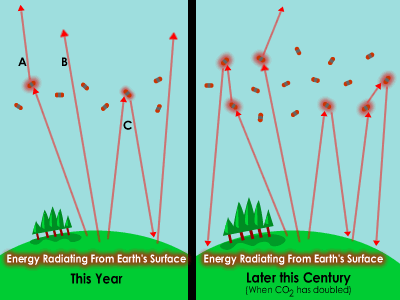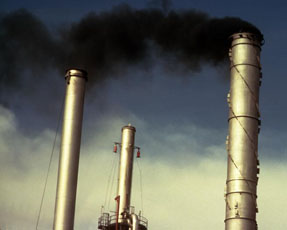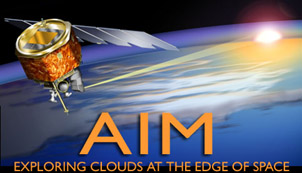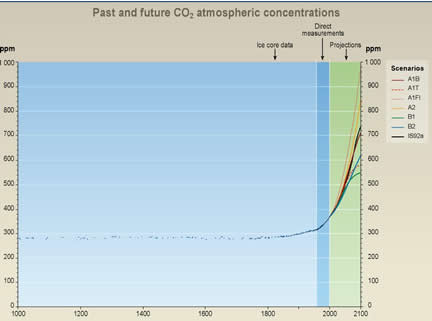This graph shows how the amount of carbon dioxide, a greenhouse gas in the Earth’s atmosphere, has changed over time and how it is expected to change in the future.
Click on image for full size
IPCC 2001 Third Assessment Report
The Changing Atmosphere Affects Earth's Climate
The molecules in Earth's atmosphere are always moving and changing as elements such as carbon, nitrogen and oxygen cycle in and out of the air and change through chemical reactions. Even through the individual elements are changing, the proportions of different elements within the atmosphere stays remarkably stable. This stable yet changing state is called dynamic equilibrium. Even though there is equilibrium, there are seasonal changes in Earth’s atmosphere.
Despite the dynamic equilibrium, scientists have found that the amount of greenhouse gases in Earth’s atmosphere has increased over the last 150 years. The rise in amount of greenhouse gases is directly related to human activities such as the burning of fossil fuels, deforestation, and curing of concrete. Humans are affecting the equilibrium and Earth’s cycles such as the carbon cycle, the nitrogen cycle and the water cycle, fundamentally influencing the planet as a whole.
The chemistry of the atmosphere determines what wavelengths of solar radiation are not able to enter the atmosphere, and how much radiation becomes trapped on its way out of the Earth system. Greenhouse gases trap heat through the greenhouse effect. There were greenhouse gases in the atmosphere long before humans affected the system. Having some greenhouse gases in Earth’s atmosphere is beneficial because they keep temperatures mild and suitable for life. However, as the concentration of greenhouse gases has risen, so has Earth’s global temperature. This is causing changes to environments and ecologies worldwide.
Last modified August 13, 2004 by Lisa Gardiner.
You might also be interested in:

An element (also called a "chemical element") is a substance made up entirely of atoms having the same atomic number; that is, all of the atoms have the same number of protons. Hydrogen, helium, oxygen,
...more
Less than 1% of the gases in Earth's atmosphere are called greenhouse gases. Even though they are not very abundant, these greenhouse gases have a major effect. Carbon dioxide (CO2), water vapor (H2O),
...more
Energy from the Sun can enter the atmosphere, but not all of it can easily find its way out again. This is a natural process called the greenhouse effect. Without any greenhouse effect, Earth’s temperature
...more
Leaders from 192 nations of the world are trying to make an agreement about how to limit emissions of heat-trapping greenhouse gases, mitigate climate change, and adapt to changing environmental conditions.
...more
Climate in your place on the globe is called regional climate. It is the average weather pattern in a place over more than thirty years, including the variations in seasons. To describe the regional climate
...more
Television weather forecasts in the space age routinely feature satellite views of cloud cover. Cameras and other instruments on spacecraft provide many types of valuable data about Earth's atmosphere
...more
Predicting how our climate will change in the next century or beyond requires tools for assessing how planet responds to change. Global climate models, which are run on some of the world's fastest supercomputers,
...more















